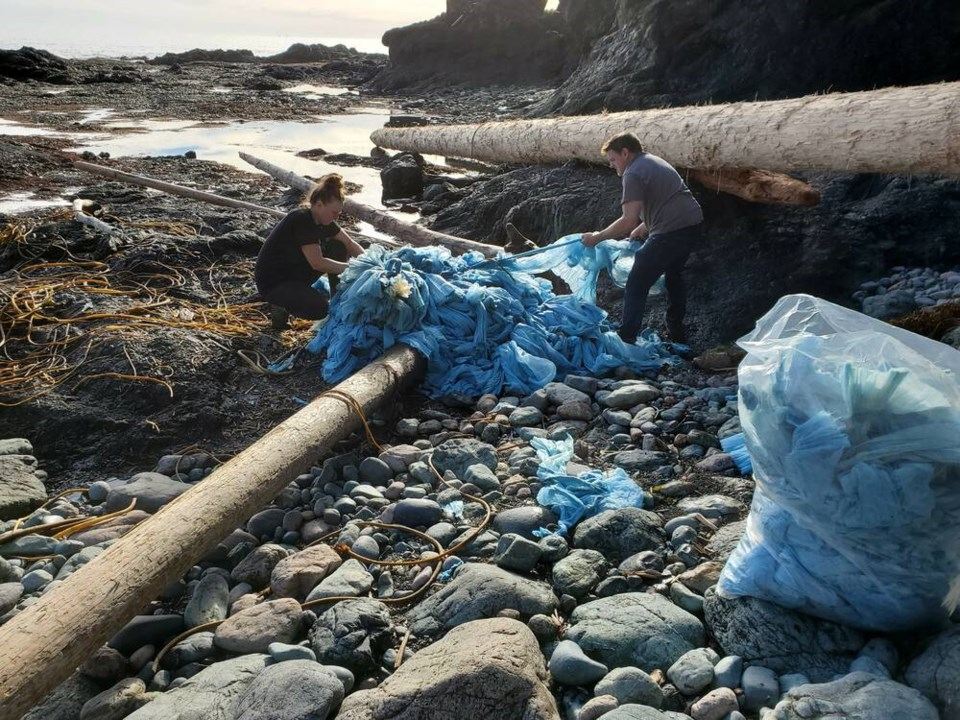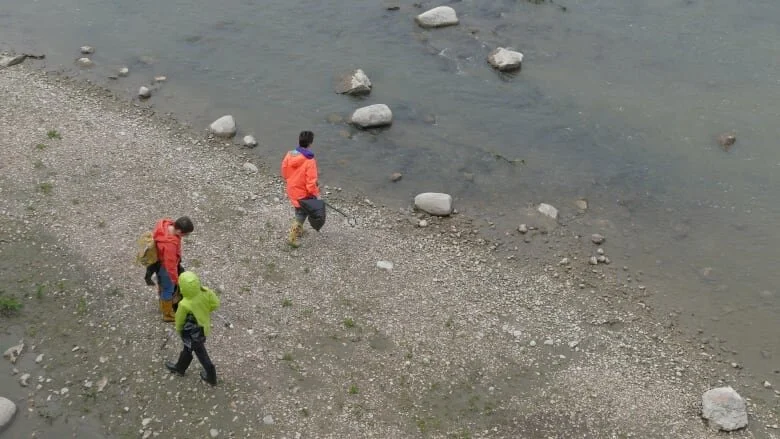One of the primary concerns the province expressed in recent court filings about Trevali going bankrupt or into receivership was the need to treat acidic water at the mine and to pump water out of the underground portion of the mine. The filings say that without security, there was a risk thieves could interrupt the mine's power supply and halt water treatment, which could cause environmental damage.
Climate change causing more frequent warm winter temperatures: extreme weather expert
Climate change is causing mild winter temperatures to become more frequent across the country, one extreme weather expert says. Parts of southern Ontario have seen unseasonably warm temperatures and rainfall warnings in recent days, with some local conservation authorities warning the public to stay away from waterways as water levels are expected to rise due to rain and melting snow.
GOLDSTEIN: The last straw -- Canada's single use plastics ban means more garbage
While the impact analysis says here will be a net environmental benefit from eliminating single use plastics, including the reduction of 1.8 million megatonnes of greenhouse gases annually, it also says some substitutes will have a higher climate change impact, as well as negative effects on air and water quality. The government says, based on 2019 data, that 15.5 billion plastic grocery bags a year were being sold in Canada, 5.8 billion straws, 4.5 billion pieces of cutlery, three billion stir sticks, 805 million takeout containers and 183 million six-pack rings. The six categories of single use plastics subject to the ban account for an estimated 160,000 tonnes of plastic waste annually, just 5% of the overall amount of 3.3 million tonnes of plastic waste. Of that, 86% ends up in landfills, 4% is burned, a dismal 9% is recycled — so much for all those years of faithful blue box recycling — and about 1%, or 29,000 tonnes, is discharged into the environment as litter, with 2,500 tonnes ending up in oceans, lakes and rivers.
Province Announces New Protected Areas, Funding to Protect More Land
The Province is investing an additional $20 million to help protect more of Nova Scotia’s land and water and designating another 9,300 hectares of Crown land for the benefit of Nova Scotians and the environment. Environment and Climate Change Minister Timothy Halman made the announcements today, December 12, in Middle Sackville near the newly designated Sackville River Wilderness Area. It covers about 800 hectares of mature forests, wetlands, lakes and waterways. This protected area will help conserve the Sackville River, the Pockwock watershed, which provides communities with drinking water, and recreation areas.
Tribes Say BC Mine Waste Threatens Water, Way of Life
Tribal representatives from across the Northwest are flying into Washington, D.C. this week to discuss how mine waste in British Columbia is threatening their way of life. With plans in the Canadian province for doubling the number of mines, tribes say waste already affects waterways downstream in the U.S. Richard Janssen Jr. is the Department Head of Natural Resources for the Confederated Salish and Kootenai Tribes, and is in D.C. this week. He said selenium waste from mines near the Elk River north of Montana has a detrimental effect on waterways.
Research from UBC Okanagan suggest tire particles impact fresh water
If you have ever been curious as to what happens to the rubber tread that wears off of a vehicle's tires, then you are in luck. Modelling by a team of researchers at the UBC Okanagan has discovered that an increasing amount of microplastics from tires and roadways are ending up in lakes and streams. From the university's School of Engineering, researchers have developed a framework for examining potential contamination that originates from the use of vehicles on roads and highways.
P.E.I. government to raise fines for shoreline violations to $50K
The provincial government is planning to increase the fines for damaging the sensitive buffer zone around P.E.I.'s shorelines and waterways to $50,000, up from $3,000. The province has had rules for these ecologically sensitive areas since the late 1990s, including needing a permit to cut down trees or disturb the ground and soil in areas close to the water. But Minister of Environment, Energy and Climate Action Steven Myers said those rules and the current fines aren't working. "We are finding that the low fine level is creating a lot of issues right across the board," Myers told Island Morning host Mitch Cormier.
Montreal aims to minimize overflows during Marcotte wastewater project
Montreal, which was the last major city in North America to begin treating its wastewater, will boost its reputation with the launch of $360 million in wastewater treatment upgrades including work to install an ozone wastewater disinfection process at its J.-R.-Marcotte wastewater treatment plant. Pomerleau was awarded a contract of $93.2-million last March to kick off the ozone project. Work will get underway in phases with various shutdowns required. The plant will remain operational at all times, but its treatment capacity will have to be reduced for two periods of six months, the first from the first day of this November to April 30, 2023.
Heavy rainfall, slow snowmelt helps marine life thrive in B.C. rivers, waterways
Freshwater scientists and biologists in B.C.'s Cowichan Valley say marine life in the area is thriving this spring, with the combination of heavy rainfall and late spring thaw resulting in higher water levels in rivers and other waterways. "For river levels, generally at this time of year we like to see ... seven to 15 cubic metres per second. This year, we're running about 30," said Tom Rutherford, the executive director of the Cowichan Watershed Board. He said in his 30 years of experience, he's never seen water levels this high.
Whitehorse one of the only cities in the world to measure airborne microplastics
Microplastic pollution is usually associated with the ocean where it's been widely studied, but new research shows those tiny particles can be found in the air as well, even in the Yukon. A team of researchers at Yukon University have been monitoring the amount of microplastics being deposited from the atmosphere into the air around Whitehorse over the past two years.
Ontario's feral goldfish population is exploding and climate change may be to blame
For years, Andrew Murray would see the small schools of goldfish living in the storm pond near his home in suburban London, Ont. He never thought much of them until this spring, on a sunny day in April when the normally greenish pond had an unusual, if not slightly orange tinge. An avid nature photographer, he captured a few close-ups. It wasn't until he got home and looked at the pictures that he realized how many goldfish must be swimming around in there.
Stay clear, stay safe this Easter weekend
After a long winter, Easter weekend is a great time to get outside to enjoy the warming weather. But if adventures in the great outdoors are part of your weekend plans, please ensure you stay clear of waterways around OPG hydroelectric facilities. Recent snow melt, combined with spring precipitation, has the potential to cause rising water levels. High water flow, melting snow and ice, and unstable banks along waterways can be especially dangerous at this time of year.
New research finds climate change affecting food supplies for First Nation in Ontario
First Nations across the widely-differing regions of Ontario are finding something ominous in common—unpredictable and unexpected changes to food supply tracing back to climate change. A pattern is emerging through research and interviews conducted on food security with members of the Anishinabek Nation, a representative body for 39 First Nations across the province.
Ice jams could lead to unexpected flooding in West Montrose, New Hamburg: GRCA
Warm weather that melted snow and rain over the weekend has weakened ice on local waterways, including the Grand River, which could lead to ice jams and unexpected flooding, the Grand River Conservation Authority warns. There is an increased "potential for rapidly changing conditions" on local waterways, the authority said in a flood watch message Monday.
She wants Montrealers to forge a connection with the water that surrounds them
When Cyrielle Noël learned how to swim at the age of two, it was the start of a lifelong love of water and fascination with the waterways that surround the island of Montreal. That curiosity helped spawn a career in urban planning with a specific focus on the use of marine spaces. Noël works for Ocean Bridge, an organization that connects youths and young professionals across Canada and encourages them to create projects aimed at ocean conservation.
Disposable face masks lead to more microplastics in waterways: Canadian study
The use of disposable face masks as a result of the COVID-19 pandemic has led to more microplastics in waterways, a recent study from Canadian researchers has found. Microplastics are tiny plastic particles that are less than 5 millimetres long and are created through the degradation of discarded plastic-containing products. These particles have been observed polluting various natural ecosystems, particularly aquatic environments.
New research shows glyphosate could be harmful to freshwater ecosystems
Some residents in Colchester County, N.S., are worried about the effects of the herbicide glyphosate being sprayed on land near waterways, and new research out of McGill University suggests there is cause for concern. Glyphosate is used in the forestry industry to kill deciduous trees, allowing the softwoods sought by harvesters to grow unhampered. Every year, Nova Scotia's Environment Department issues permits to companies to spray the herbicide in forests around the province.
Taking it to the bank: Dozens clean up litter along Winnipeg's Assiniboine River
The banks of Winnipeg's Assiniboine River are a little bit cleaner after dozens of people helped pick up litter near Assiniboine Park on Saturday afternoon. The effort was part of the Great Canadian Shoreline Cleanup, a long-standing national conservation initiative that teaches people about the harmful effects of shoreline and riverbank litter and encourages them to get involved in stopping it. Marc Brandson, curator of animal care at the Assiniboine Park Zoo in Winnipeg, said the group focused on cleaning up any waste found along the banks of the Assiniboine that might eventually find its way into the river system.
Nova Scotia researchers hit the water for Love Your Lake data-gathering work
Love Your Lake is a national evaluation program developed by the Canadian Wildlife Federation and Watersheds Canada. So far it’s gathered information on 35,000 shoreline properties across the country. The project recently expanded to Nova Scotia beginning with Porters Lake, a 19-kilometre long lake on the Eastern Shore. “We will be conducting the assessments on the water with volunteer boaters and we don’t actually go on the properties, on the parcels, at all,” said Hebb, a fourth-year environmental studies student at Saint Mary's University. “We just take our assessment data sheets and we fill those out and then we log them in our data software.”
TESTER CALLS ON STATE DEPARTMENT TO TACKLE TRANSBOUNDARY WATER POLLUTION
U.S. Senator Jon Tester is calling on the U.S. State Department to get involved in the ongoing effort to stem the flow of pollution from Canadian mines to waterways in Northwest Montana. In a letter, Tester urged Secretary of State Antony Blinken to request a referral to the International Joint Commission (IJC) concerning the selenium contamination issue in the Kootenai watershed in Montana, and for the State Department to engage with the Canadian government and the IJC to resolve this critical transboundary water quality issue.





















